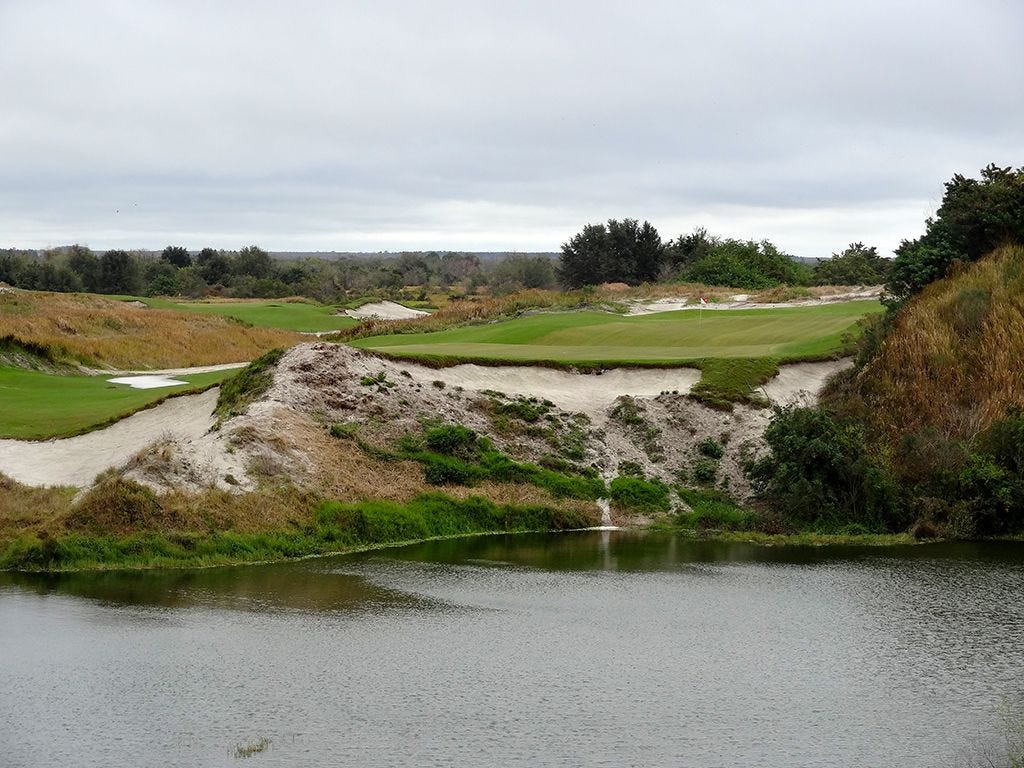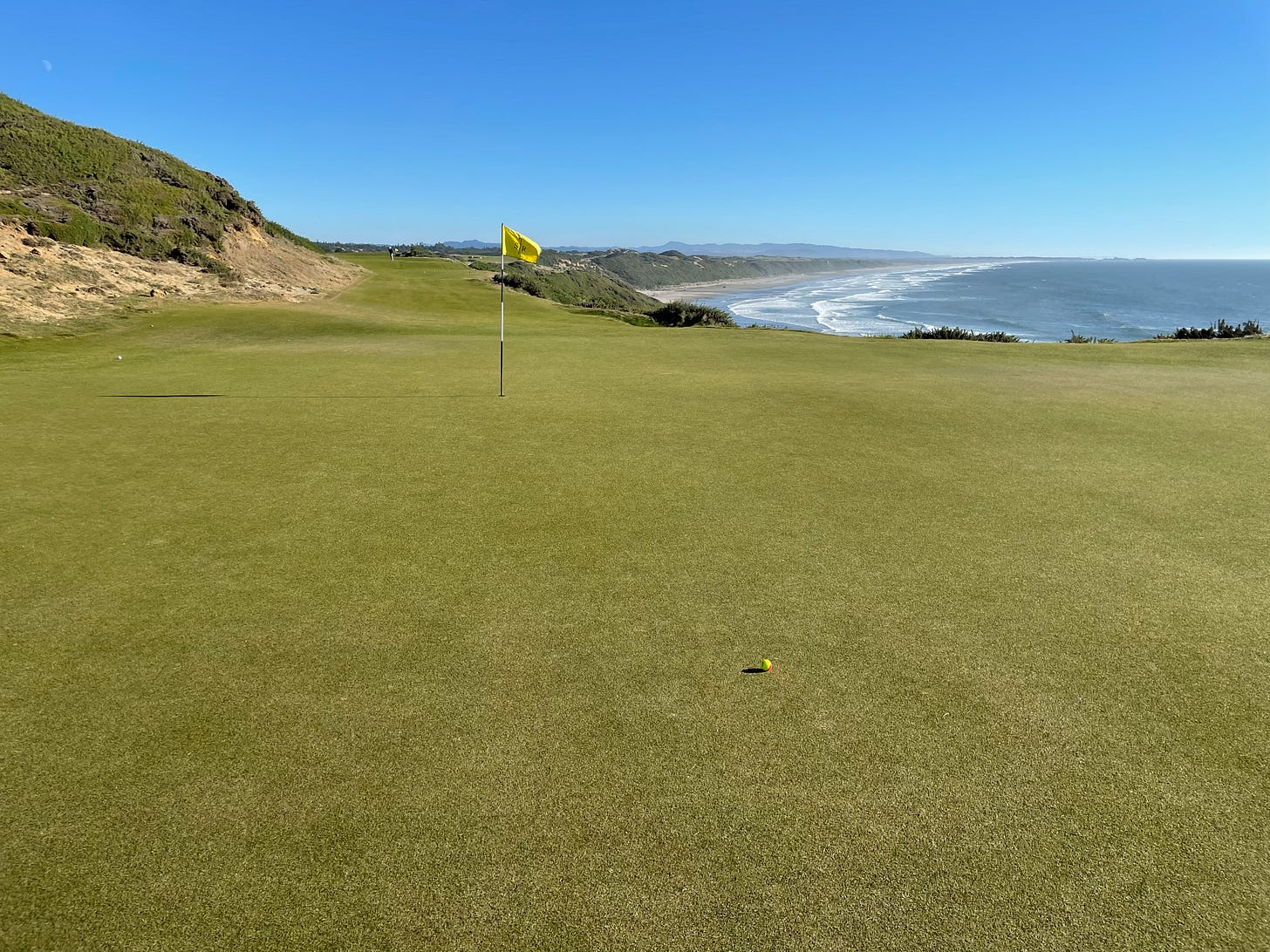My Favorite Golf Architects, Vol. 2
Let's jump into the wild world of Bill Coore and Ben Crenshaw
What do you do when you’re a professional golfer and your career has winded down? Some continue onto the senior Champions Tour. Others go into media. Many just retire and laugh about how they’ve gamed the system and made millions playing a game while not really jeopardizing their health in any real way.
And others go into golf course design. Only a few ex-players are any good at this, to be clear. I’ve mentioned my distaste for most Jack Nicklaus designed courses. Arnold Palmer designed many courses, most of them kind of bland (though I can’t wait to play Tralee in Ireland next summer, which most describe as not feeling in any way like an Arnold Palmer course). Other guys like Tom Weiskopf, Johnny Miller, Greg Norman, Gary Player and others either design courses or pay others to do so and get their name on it. (One of the worst courses I’ve ever played, The Bridges in San Ramon, is a Johnny Miller course. Legend has it at the opening ceremony he muttered to someone that he wished he’d seen it before it opened as he too absolutely hated it.)

Ben Crenshaw was not quite the golfer of Nicklaus, Palmer or Player, but he was incredibly successful. He won 19 times on the PGA Tour and 30 times worldwide, and that included two Masters victories and 2nds and 3rds at the other three majors. (His Wikipedia page notes, however, he has the worst playoff record of all time, going 0-8. Ouch!)
But when he paired up with Bill Coore in the mid-1980s and started designing golf courses, that’s where he really started to shine for me. Sure, I remember him breaking down after he won the 1995 Masters to honor his mentor Harvey Penick, and he was always a classy guy. But the golf courses Coore & Crenshaw have designed are incredible.

At Bandon Dunes, they are responsible for Bandon Trails, Sheep Ranch and the short course The Preserve. They designed Sand Valley and the short course The Sandbox. They did the Red course at Streamsong, my favorite of all the three courses there. And they renovated Donald Ross’ masterpiece, Pinehurst No. 2 in a brilliant and understated way. These are just the courses they’ve been behind that I’ve played, but their overall portfolio is basically a “bucket list” for me too.
Understated is perhaps the best descriptor of why I like their courses so much. Most of all these courses are really wide open, with huge fairways with tons of undulations. The lone exception to this is Streamsong Red which does have more forced carries over water than I tend to like, but on MOST holes there are bailout areas if you just want to make the hole longer. Amidst that water are huge bunkers that look natural and windblown, not like they were carved and shaped with a stencil like many older golf course designs.
Bandon Trails is the black sheep of Bandon, barely acknowledging the coast, but the vibes there are tremendous and it’s insanely fun to play. The Preserve might be the most fun short course in the world. And while I probably rank Sheep Ranch lowest of all the Bandon courses, that’s still high enough to be really up there for me and it has some of the best golf holes I’ve played anywhere. (Some others are clearly crammed in and there’s a bit of repetition there for my taste.)

When I was in Sand Valley a few weeks ago, I got confused and thought that Tom Doak had designed that course. (In reality, he’s designing TWO new courses at Sand Valley, neither of which are open currently.) As a fan of Doak, I thought this might be one of his best - because unlike some of his courses, the greens there were tough but not tricked out (my main Doak complaint). And then I looked into it and realized it was a Coore & Crenshaw design and it just made sense.
Because Sand Valley might be the definitive C&C design that I’ve played. The fairways are WIDE open, but you can get a bad lie even in the middle of a fairway because of the bumps and lumps. There are a ton of waste area/bunkers, but sometimes it’s better to be there than in the rough. And those bunkers are wild. In fact, the whole course feels “wild,” as if it emerged from the sea that way. (And it’s in Wisconsin!) It’s a truly fun course to play, and I suspect would be terrific to play a second or third time.
What’s interesting to me is that their stated philosophy on their website doesn’t really immediately reflect this to me:
…traditional, strategic golf is the most rewarding, and the creation of courses that present this concept with the greatest artistry is the ultimate goal.
I mean, there’s very little “traditional” about Sand Valley or Streamsong Red. They are QUITE strategic, and I love that about them, so I’m here for that. The note on artistry took me aback a bit - I read that first as “make sure it looks pretty” which often matters not a whit in how fun a course is to play. But man, all of their courses do, in fact, look gorgeous. Even Pinehurst No 2., which absolutely bodied me when I played it, is stunning in its simplicity. It’s a testament to them that they didn’t rush to put “their stamp” on a national treasure like that when they renovated it. In fact, they removed grass (35 acres!) and replaced it with more natural areas (waste areas, essentially) that were lurking beneath the Bermuda. It’s a course any serious golfer wants to play, and they should.
Coore & Crenshaw is developing a course near Napa called Brambles that should open up next year, and will immediately go onto my list to play. They designed Cabot Cliffs, one of the courses up in Nova Scotia I hope to eventually find a reason to visit. Sand Hills, Te Aria (New Zealand), Lost Farm (Australia), Friar’s Head and Trinity Forest are already on my ever growing golf bucket list.
You know you’ve made it to a certain level of golf dorkery when you start getting excited about a golf course based on the architect, and Coore & Crenshaw are absolutely part of that group for me.






